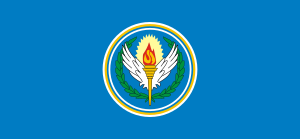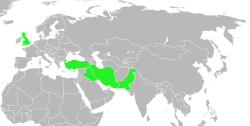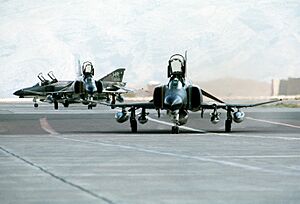Central Treaty Organization facts for kids

Flag
|
|

CENTO members shown in green
|
|
| Abbreviation | CENTO |
|---|---|
| Formation | 24 February 1955 |
| Dissolved | 16 March 1979 |
| Type | Intergovernmental military alliance |
| Headquarters | Baghdad (1955–1958) Ankara (1958–1979) |
|
Region served
|
Eurasia |
|
Membership
|
5 states
|
The Central Treaty Organization (CENTO) was a group of countries that worked together for military protection. It was first called the Middle East Treaty Organization (METO) or the Baghdad Pact. It was formed on February 24, 1955, during the Cold War.
The original members were Iran, Iraq, Pakistan, Turkey, and the United Kingdom. The main goal was to stop the spread of Soviet influence in the Middle East. The United States helped with the talks but did not join as a full member until 1958. CENTO was dissolved on March 16, 1979.
The organization's main office was in Baghdad, Iraq, from 1955 to 1958. After that, it moved to Ankara, Turkey, and stayed there until 1979. Cyprus was also important because the British had military bases there.
Contents
What Was CENTO?
CENTO was like a smaller version of NATO (the North Atlantic Treaty Organization). It made its member countries promise to help each other if they were attacked. They also agreed not to interfere in each other's internal affairs.
The main idea was to create a strong line of countries along the Soviet Union's southern border. This was called the 'Northern Tier'. It aimed to prevent the Soviet Union from expanding into the Middle East. Unlike NATO, CENTO did not have a single military command. Also, there were not many American or British military bases in member countries. However, the United States did have special communication and spy facilities in Iran and Pakistan.
History of CENTO
In 1958, a new government took over in Iraq. This new government decided to leave the Baghdad Pact. Because of this, the organization changed its name to CENTO. Its headquarters also moved from Baghdad to Ankara, Turkey.
The 1960s were a difficult time in the Middle East and South Asia. There were conflicts like the Arab–Israeli conflict and wars between India and Pakistan. CENTO did not get involved in these disputes. For example, Pakistan asked for help from CENTO in its wars with India in 1965 and 1971. But CENTO refused, saying its purpose was to stop the Soviet Union, not to fight India.
CENTO also struggled to stop the Soviet Union from gaining influence in other countries nearby. The Soviets made strong military and political friendships with countries like Egypt, Syria, and Libya. By 1970, the Soviet Union had many troops in Egypt and naval bases in other countries. This meant they had "leap-frogged" over the CENTO member states.
The end of CENTO came in 1979 with the Iranian Revolution. But the organization had already become much weaker. This happened after Turkey invaded Cyprus in 1974. The United Kingdom then pulled its forces that were meant for CENTO. The United States also stopped military aid to Turkey. With the fall of the Iranian monarchy, there was no longer a strong reason for CENTO to exist.
On March 16, 1979, CENTO was officially dissolved. Future defense agreements between the U.S., Britain, and countries in the region were done one-on-one.
Who Were the Members?
The countries that were part of CENTO included:
 United Kingdom (joined April 1955)
United Kingdom (joined April 1955) Iraq (until March 1959)
Iraq (until March 1959) Iran (joined November 1955 – left March 1979)
Iran (joined November 1955 – left March 1979) Pakistan (joined September 1955 – left March 1979)
Pakistan (joined September 1955 – left March 1979) Turkey
Turkey
Turkey was seen as very important to the alliance. Western countries hoped Turkey could encourage other Arab nations to join the anti-communist group.
Key Dates for CENTO
- February 1954: Turkey and Pakistan sign a cooperation agreement.
- February 24, 1955: Iraq and Turkey sign a military agreement in Baghdad. This starts the "Baghdad Pact." The UK, Pakistan, and Iran join later that year.
- October 1958: The Baghdad Pact headquarters moves from Baghdad to Ankara.
- March 5, 1959: The U.S. signs military agreements with Pakistan, Iran, and Turkey.
- March 24, 1959: Iraq leaves the alliance.
- August 19, 1959: The Middle East Treaty Organization (METO) is renamed CENTO.
- 1965: Pakistan asks for help from its allies in a war with India, but CENTO does not get involved.
- 1971: Pakistan again tries to get allied help in another war with India, but it is unsuccessful.
- 1974: The United Kingdom pulls its forces from the alliance after Turkey invades Cyprus.
- March 11, 1979: Iran leaves CENTO.
- March 12, 1979: Pakistan leaves CENTO.
- March 16, 1979: CENTO is officially disbanded. The United Kingdom and Turkey also leave.
CENTO Railway Project
CENTO also supported building a railway line. Part of this railway was completed to connect London and Tehran (the capital of Iran) through Van. A section from Lake Van in Turkey to Sharafkhaneh in Iran was built. This part was funded mostly by CENTO, especially the UK. Building it was very difficult because of the mountains and tough land. The railway even included a ferry across Lake Van!
Other CENTO Activities
Like NATO, CENTO also supported non-military activities. These included cultural and scientific research projects.
- CENTO held conferences on public health.
- It had a Cultural Works Programme.
- It created the CENTO Institute of Nuclear & Applied Science.
- It had a Scientific Coordinating Board and a Scientific Council.
- It held events on rural development.
These groups worked on many projects, especially in farming and development. For example, in 1960, CENTO funded 37 projects related to farming, education, health, and transportation. They even held a meeting about animal diseases like foot-and-mouth disease.
The CENTO Institute of Nuclear Science was first in Baghdad, Iraq. But after Iraq left CENTO, it moved to Tehran, Iran, in 1958. Students from Pakistan, Turkey, and Iran were trained there.
See also
- ANZUS
- Arab–Israeli alliance against Iran
- Balkan Pact (1953)
- Economic Cooperation Organization
- Inter-American Treaty of Reciprocal Assistance
- Islamic Military Counter Terrorism Coalition (IMCTC)
- NATO
- Regional Cooperation for Development
- Southeast Asia Treaty Organization


